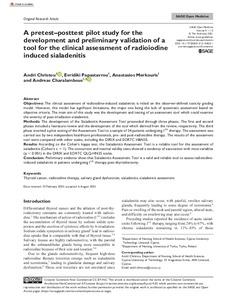A pretest-posttest pilot study for the development and preliminary validation of a tool for the clinical assessment of radioiodine induced sialadenitis
Christou Andri; Papastavrou Evridiki; Merkouris Anastasios; Charalambous Andreas
https://urn.fi/URN:NBN:fi-fe2021120158345
Tiivistelmä
Objectives: The clinical assessment of radioiodine-induced sialadenitis is relied on the observer-defined toxicity grading model. However, this model has significant limitations, the major one being the lack of systematic assessment based on objective criteria. The main aim of this study was the development and testing of an assessment tool which could examine the severity of post-irradiation sialadenitis.
Methods: The development of the Sialadenitis Assessment Tool proceeded through three phases. The first and second phases included a literature review and the development of the tool which derived from the review, respectively. The third phase involved a pilot testing of the Assessment Tool to a sample of 34 patients undergoing I-131 therapy. The assessment was carried out by two independent healthcare professionals, pre- and post-radioiodine therapy. The results of the assessment tool were compared with other scales, including the DIRIX and EORTC H&N35.
Results: According to the Cohen's kappa test, the Sialadenitis Assessment Tool is a reliable tool for the assessment of sialadenitis (Cohen's kappa = 1). The concurrent and internal validity tests showed a tendency of association with most variables (p < 0.001) in the DIRIX and EORTC QLQ-HN35 scales.
Conclusion: Preliminary evidence show that Sialadenitis Assessment Tool is a valid and reliable tool to assess radioiodineinduced sialadenitis in patients undergoing I-131 therapy post-thyroidectomy.
Kokoelmat
- Rinnakkaistallenteet [27094]
